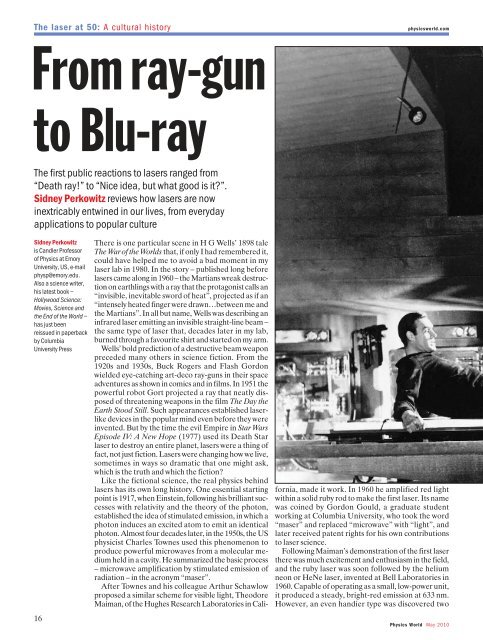special issue
special issue
special issue
You also want an ePaper? Increase the reach of your titles
YUMPU automatically turns print PDFs into web optimized ePapers that Google loves.
The laser at 50: A cultural historyphysicsworld.comFrom ray-gunto Blu-rayThe first public reactions to lasers ranged from“Death ray!” to “Nice idea, but what good is it?”.Sidney Perkowitz reviews how lasers are nowinextricably entwined in our lives, from everydayapplications to popular cultureSidney Perkowitzis Candler Professorof Physics at EmoryUniversity, US, e-mailphysp@emory.edu.Also a science writer,his latest book –Hollywood Science:Movies, Science andthe End of the World –has just beenre<strong>issue</strong>d in paperbackby ColumbiaUniversity Press16There is one particular scene in H G Wells’ 1898 taleThe War of the Worlds that, if only I had remembered it,could have helped me to avoid a bad moment in mylaser lab in 1980. In the story – published long beforelasers came along in 1960 – the Martians wreak destructionon earthlings with a ray that the protagonist calls an“invisible, inevitable sword of heat”, projected as if an“intensely heated finger were drawn… between me andthe Martians”. In all but name, Wells was describing aninfrared laser emitting an invisible straight-line beam –the same type of laser that, decades later in my lab,burned through a favourite shirt and started on my arm.Wells’ bold prediction of a destructive beam weaponpreceded many others in science fiction. From the1920s and 1930s, Buck Rogers and Flash Gordonwielded eye-catching art-deco ray-guns in their spaceadventures as shown in comics and in films. In 1951 thepowerful robot Gort projected a ray that neatly disposedof threatening weapons in the film The Day theEarth Stood Still. Such appearances established laserlikedevices in the popular mind even before they wereinvented. But by the time the evil Empire in Star WarsEpisode IV: A New Hope (1977) used its Death Starlaser to destroy an entire planet, lasers were a thing offact, not just fiction. Lasers were changing how we live,sometimes in ways so dramatic that one might ask,which is the truth and which the fiction?Like the fictional science, the real physics behindlasers has its own long history. One essential startingpoint is 1917, when Einstein, following his brilliant successeswith relativity and the theory of the photon,established the idea of stimulated emission, in which aphoton induces an excited atom to emit an identicalphoton. Almost four decades later, in the 1950s, the USphysicist Charles Townes used this phenomenon toproduce powerful microwaves from a molecular me -dium held in a cavity. He summarized the basic process– microwave amplification by stimulated emission ofradiation – in the acronym “maser”.After Townes and his colleague Arthur Schawlowproposed a similar scheme for visible light, TheodoreMaiman, of the Hughes Research Laboratories in Cali -fornia, made it work. In 1960 he amplified red lightwithin a solid ruby rod to make the first laser. Its namewas coined by Gordon Gould, a graduate studentworking at Columbia University, who took the word“maser” and replaced “microwave” with “light”, andlater re ceived patent rights for his own contributionsto laser science.Following Maiman’s demonstration of the first laserthere was much excitement and enthusiasm in the field,and the ruby laser was soon followed by the heliumneon or HeNe laser, invented at Bell Laboratories in1960. Capable of operating as a small, low-power unit,it produced a steady, bright-red emission at 633 nm.However, an even handier type was discovered twoPhysics World May 2010



